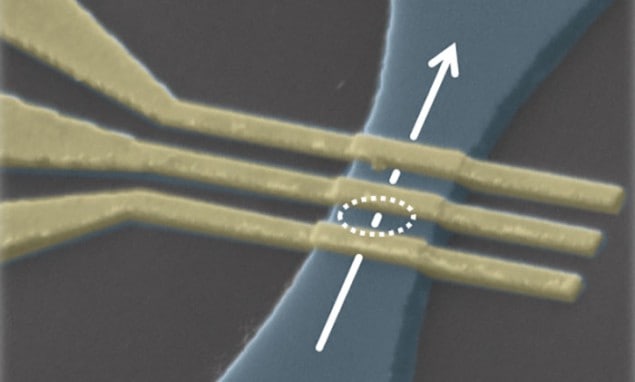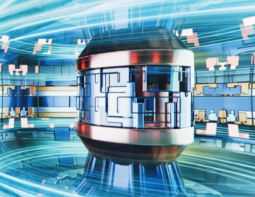
Physicists should finally be able to rid themselves of the cumbersome and inaccurate definition of the ampere. That is the claim of metrologists in Germany, who have measured electrical current by counting single electrons travelling along a microscopic wire. The researchers say that their technique will allow scientists in a number of different disciplines to make better measurements of tiny currents.
The move to revamp the ampere is part of a more general overhaul of the SI system of units. It is envisaged that all seven base units – the ampere, second, metre, kilogram, kelvin, mole and candela – will be anchored to unvarying constants of nature. In particular, scientists are eager to redefine the kilogram, which is currently based on the mass of a specific lump of platinum-iridium sitting in a Paris safe and slowly shedding atoms.
It is partly to sever its link with the kilogram that metrologists are keen to redefine the unit of electrical current. At the moment, one ampere is defined as the current flowing in two narrow, infinitely long parallel conductors placed one metre apart in a vacuum that generate between them a force of 2 ×10–7 N for every metre of length. This formulation is a problem because it means that the ampere is defined in terms of the kilogram (as well as the metre and the second) because force is equal to mass times acceleration. Also, nothing can be infinitely long, so this requirement must be approximated somehow.
Transistor-like device
This latest work was carried out by Frank Hohls and colleagues at the German National Metrology Institute (PTB) in Braunschweig and aims to define the ampere in terms of a certain (large) number of single electrons passing through a conducting channel in unit time. Central to the proposal is the construction of a “single-electron pump”, a transistor-like device that transmits just one electron when activated by a gate voltage. With the voltage oscillating perhaps several billion times a second, the device would generate a current that is large enough to calibrate an ammeter – thus revealing how accurate the instrument is.
The team made single-electron pumps from quantum dots – sub-micron sized conducting areas etched on to semiconductor substrates. Operating the pumps at millikelvin temperatures, they apply a roughly 0.5 GHz gate voltage and a second, fixed voltage across each dot to set up a time-varying potential well that briefly captures and then ejects single electrons. To establish the accuracy of their devices, the researchers use a specially developed amplifier that converts the current flowing through it into a voltage, which is measured by a voltmeter calibrated using two other quantum phenomena – the quantum Hall effect and the Josephson effect.
The researchers were able to measure the current transmitted by the pumps with an accuracy of 0.16 parts per million. This is fractionally better than they achieved with an earlier version of their device last year, which matched the accuracy of measurements that can be carried out using the existing force-based definition of the ampere – 0.2 parts per million. The new measurements were also done more quickly – requiring just 21 hours, rather than the several days employed a year ago. “The measurement set-up used in this experiment represents the state-of-the-art in small-current metrology,” says group member Hansjörg Scherer.
Aerosol counting
According to Scherer, who led the PTB effort to design the new amplifier, more accurate measurements made possible by the pumps could prove useful in a number of areas. Among them, he says, are the determination of radioactivity levels in ionization chambers and counting aerosol particles in the air.
Ian Mills, a metrology expert at the University of Reading in the UK, praises the “valuable and excellent work” being done on electron counting at the PTB. But he believes that a better definition of the ampere can be obtained simply by using the most accurate value for the electron charge available today – which is based on other measurements including that of the fine structure constant. That value of the ampere has an accuracy of about 20 parts in a billion and is, he says, most likely to be used in the new definition of the ampere that should be approved by the General Conference on Weights and Measures – the body that will authorize changes to the SI system. “I think the electron-counting experiments are fascinating,” he says, “but they are not yet sufficiently precise to compete.”
François Piquemal of the National Metrology and Testing Laboratory (LNE) in Paris, takes a slightly different view, arguing that electron counting offers a way of realizing the ampere in practice, rather than defining it. He maintains that single-electron pumps are best suited to measuring currents up to about a nanoamp, while an alternative approach – involving the combination of quantum Hall and Josephson standards through Ohm’s law – is best for larger currents. “In my opinion, these two methods are complementary for the future mise en pratique of the ampere,” he says.
The research is described in a paper that will be published in Metrologia.



